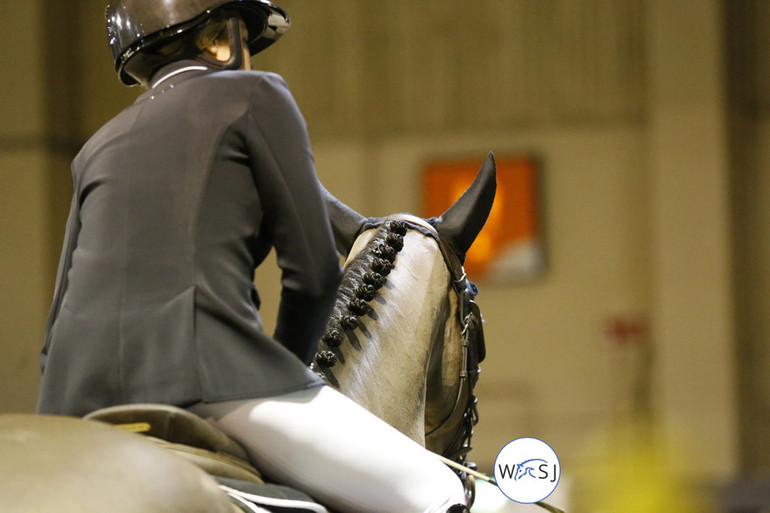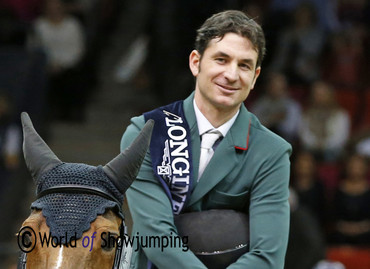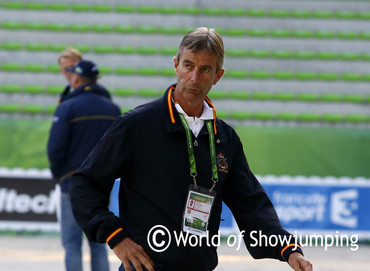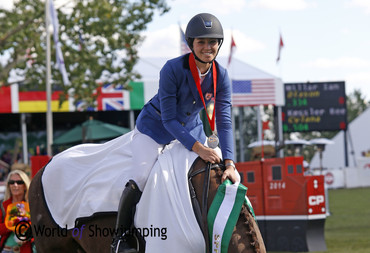Steve Guerdat, Eric van der Vleuten and Reed Kessler speak out about the invitation system for the Global Champions Tour, harmonizing entry fees world wide and where it could bring our sport.
Steve Guerdat (SUI) – 2012 Olympic Champion and reigning World Cup Champion, current world rank 11:
“Looking at the invitation system for the Global Champions Tour and Global Champions League, it’s hard to get the picture when only talking about percentages. When the rules state that 30 % of the riders participating will be taken in descending order from the world ranking, it means the Top 15 riders only. So, if you are ranked 16th in the world you are actually closed off from going to a five-star show unless you – or a sponsor – find 500,000 Euro to pay yourself in on a Global Champions League-team. That is the sad truth.
I think it is unacceptable that a rider within the world’s Top 30 can be closed off from a five-star event like this. For me it is clear that we can not call these events sport anymore. A minority of those that compete at these shows do so based on performance, the majority is there because they have a big enough wallet to pay for it.
Allowing invitation rules like this, the FEI clearly shows that they do not value performance. Competing at a Global Champions Tour or in the Global Champions League is not about being good enough, but rich enough. This is not sport.
The worst is FEI President Ingmar De Vos that has stated that there are no pay cards allowed in the Global Champions Tour and Global Champions League. How does he then explain the two million Euro that has to be paid for each team, combined with the invitation rules that see 60 % of the riders coming from these teams? What is that if not pay cards?
I can’t believe the FEI goes out there on the front line to put up a fight to keep our sport in the Olympics, and then they approve rules like this. Where does that bring our sport? Certainly not to the Games in 2024. The FEI is supposed to be here to support and protect our sport, but they are not.
As to the proposal of harmonizing entry fees world wide, this is absolutely impossible. I can simply not believe that something like that will go through. It will be the end of our sport!
If the FEI should fight for anything, it should be to bring the American entry fee level in the direction of that we have in Europe – not the opposite.
The sport is already expensive enough as it is. When we take horses to 2* and 3* shows it is often younger ones, or the ones that need more experience. We use those shows to produce them, to educate them – not to win anything. Those shows are pure expenses for most riders.
If this proposal goes through, I will not be able to do the sport anymore the way I do today. Neither can my owners, they already pay a lot and then they are asked to put even more money on top.
Looking at this proposal, it will also close the door for younger riders that want to learn the job as professionals. They will never be able to afford it. The FEI should take on the role to protect these events so that talented riders can show. Instead, the are looking into suggesting to make even these shows for rich people only.
Honestly, I think it’s shocking that the FEI would even think about going in this direction.”
Eric van der Vleuten (NED) – competitor at three World Championships, three European Championships as well as seven World Cup Finals, current world rank 807:
“As to the invitation system, and the fact that some riders pay to compete – this is not something new. We know it from two and three-star level. When it comes to the invitation system for the Global Champions Tour specifically, the challenge for the riders is that there will be less within the Top 30 that will be selected based on their ranking – compared to before. So, in this case it will be very difficult for the riders to compete at these events unless they are on a team. For those who can not afford to pay to be part of a team, that might lead to pressure to chase the Top 15 or to produce results that might bring you to a spot on one of the teams.
Regardless of the new invitation system, I think there is no doubt that we still will see top sport at the Global Champions Tour shows. The world’s best riders will be there, either based on the ranking or because they will be part of a team. In my opinion, there is no question about that – the sport will not be any less than before.
For sure the invitation system will have effects.
Due to the amount of ranking classes at the Global Tours, and the huge amount of points available – there might be a possibility that we will see riders that would like to climb on the ranking buying themselves into a team. If they can afford it that is.
For riders not able to participate in the Global Tours, this will perhaps create a disadvantage as to the possibility to climb on the ranking – but they of course have chances through other five-star events that also offer competitions with good money and ranking points. If you take a look at the show calendar, there are a lot of five-star shows now – especially during the outdoor season. So, there are still plenty around to chose from for those that can not compete at the Global Champions Tour events.
The challenge I see is the huge prize money the Global Champions Tour offers compared to the Nations Cups. I think we will see more and more riders prioritizing the Global Tours as there is so much money to win, not only in the Grand Prix – but in all the classes. Then the ranking points of course comes on top as another big advantage. If you chose to go to all fifteen Global Tours, then this will limit how many other big shows you can do in addition. Of course that depends on the amount of horses a rider has for those big classes, but it is already hard enough to have two good five-star Grand Prix horses and this again limits how many of those big shows you can do.
For the equestrian industry, I think the development brings good news. There are so many five-star shows with more and more money in the classes, so the riders need more good horses – which eventually is positive for those that breed, develop and produce the horses. If they do things the right way, they can earn good money in the end because the horses sell much more expensive than before. So, for those that bring the horses through I think the development can be seen as a good one.
That brings me to the next subject. If there would actually be a harmonizing of the entry fees worldwide, that would bring the entry fees in Europe towards the American level – it would be bad news for the sport.
As I said, here in Europe we have a lot of riders that produce young horses. They use the two and three-star shows to build up and sell their horses, and make a living out of it. If the entry fees are doubled or even tripled, it will be impossible for many of these riders to keep on doing this.
Take my stable for example, should there be such an increase in the entry fees I would guess that we would have to stop jumping at those shows – the costs would just be too high.”
Reed Kessler (USA) – 2012 Olympian, current world rank 121:
“First of all I want to say that the two years that I got to do the Global Champions Tour were fantastic. The shows are amazing, and I really enjoyed it. I had a great year, I had some top horses and I broke into the world’s Top 30 which was one of the proudest accomplishments of my life. So, I was immensely proud when I earned my spot to compete in the Tour.
When I fell out of the Top 30, that was disappointing – but to be honest I was not terribly interested in doing any pay cards. I am fortunate enough that between my family and some syndicates I have on the horses, I have financial backing to do a pay card if I want to. But, if you are talking half a million Euro to ride on a team – my brain just can’t process spending that kind of money to do a handful of shows when I can put that amount into horses and developing them for the future. However, that is just me personally.
I think all the riders that have done the Global Tour-shows, understand that a certain amount of pay cards are necessary to put up those events and that prize money. But, I think once you cross this majority percentage of non-ranked rider invitations you are really compromising the integrity of the sport. I think that generally, the most ranking points you can get are in the LGCT Grand Prix classes and its fifteen of them each year. There are also lots of ranking points in the other classes at a LGCT-event. That makes it sort of a vicious circle, because in the end the riders that are invited to these shows will be the ones swapping places on the ranking but nobody else will realistically be able to break in. So, it will be those in the Top 15 and those that buy in that will enjoy the plethora of ranking points. That is a dangerous direction to head in. Can you really call it a sport then? When the majority of the people in the class paid to be there?
For me it is also important that our sport stays fair, and we have to remember the focus on the welfare of the horses. These two things should take priority. However, I think with rules like those introduced now this will be easily sacrificed. To chase the ranking and show as heavily as you can to win as much as possible to be within the Top 15 that are invited from Group 1 in the rules; not many people will have that much depth in their string of horses to be able to do that. That is not to say that the riders within the Top 15 are chasing, it’s just that there is only a small percentage of the riders that have four or five five-star Grand Prix horses to rotate so that they can show different horses week after week…
Then there is the harmonizing of the entry fees, which is something I am very passionate to talk about.
My parents started in the sport 35-40 years ago. They both come from modest beginnings. They started showing at grass root-level, and were able to start without too much funds. They worked hard, and improved. By the time I was growing up, I got to start with much more than they did. Fast forward to my generation in the States, my parents back then – they could not start now. The amount of money you have to pay to enter these shows in America, it is not possible for the majority of people. To illustrate: Last year, I took four horses to Wellington for the Winter Equestrian Festival. I won two five-star Grand Prix qualifications worth 130,000 USD each. After showing for three weeks, I could not pay my way – even with these wins. I was left with a minus.
In Europe the sport is accessible to a much bigger percentage of people, and this is what I love about living and showing here. You can go right down the road from your stables, and show at a national event for 20 Euro per class. In Europe you can ride, work, improve, climb the ladder – you don’t have to be a millionaire to become successful. If you are talking about a possibility of paying 1200-1500 Euro to enter one horse for a two or three-star show, that is the complete opposite of the accessibility we see today.
Two and three-star shows are where riders and horses develop internationally, it’s where all the horses showing at five-star level come from. You are basically clogging the drain of where all the horses and talent comes through. Why would you do that?
I think harmonizing the entry fees by moving Europe in the direction of the American levels, would be a huge mistake. And when it’s done it’s not so easy to undo. Once you have told the show organizers that it is acceptable to send their bill to the riders, it is pretty hard to convince them not to again.
It is an expensive sport as it is, but it should remain open to everyone and there should be a level playing field. The person who goes after me in the Grand Prix has the same chance I do, despite age, gender, financial background – we jump the same course, we have the same access to the same class. Taking that away takes away what makes it sport.”
Text © World of Showjumping // Pictures © Jenny Abrahamsson












